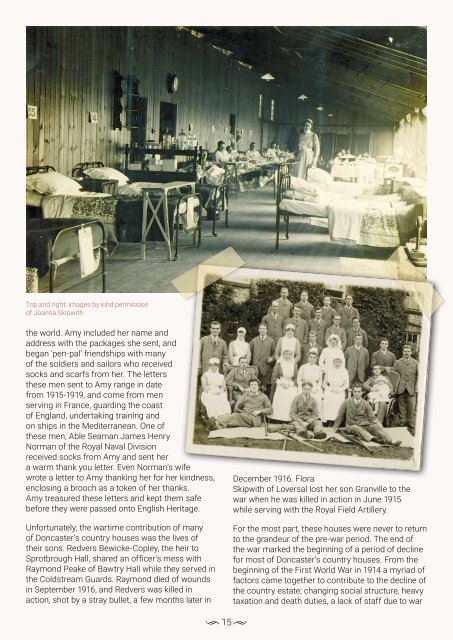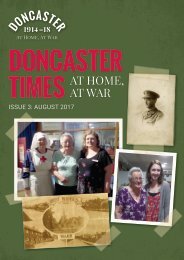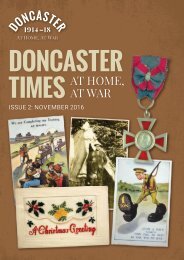Doncaster Times Issue 1 - June 2016
Doncaster Times is a biannual publication of articles and pieces researched and written by members of the public, volunteers and professionals. For its first four years, the magazine will feature articles about Doncaster during the First World War, to commemorate the centenary. The most recent publication is available in hard copy only, available to purchase from Doncaster Museum and Art Gallery, Doncaster Central Library and the Tourist Information Centre.
Doncaster Times is a biannual publication of articles and pieces researched and written by members of the public, volunteers and professionals. For its first four years, the magazine will feature articles about Doncaster during the First World War, to commemorate the centenary. The most recent publication is available in hard copy only, available to purchase from Doncaster Museum and Art Gallery, Doncaster Central Library and the Tourist Information Centre.
Create successful ePaper yourself
Turn your PDF publications into a flip-book with our unique Google optimized e-Paper software.
Top and right: images by kind permission<br />
of Joanna Skipwith<br />
the world. Amy included her name and<br />
address with the packages she sent, and<br />
began ‘pen-pal’ friendships with many<br />
of the soldiers and sailors who received<br />
socks and scarfs from her. The letters<br />
these men sent to Amy range in date<br />
from 1915-1919, and come from men<br />
serving in France, guarding the coast<br />
of England, undertaking training and<br />
on ships in the Mediterranean. One of<br />
these men, Able Seaman James Henry<br />
Norman of the Royal Naval Division<br />
received socks from Amy and sent her<br />
a warm thank you letter. Even Norman’s wife<br />
wrote a letter to Amy thanking her for her kindness,<br />
enclosing a brooch as a token of her thanks.<br />
Amy treasured these letters and kept them safe<br />
before they were passed onto English Heritage.<br />
Unfortunately, the wartime contribution of many<br />
of <strong>Doncaster</strong>’s country houses was the lives of<br />
their sons. Redvers Bewicke-Copley, the heir to<br />
Sprotbrough Hall, shared an officer’s mess with<br />
Raymond Peake of Bawtry Hall while they served in<br />
the Coldstream Guards. Raymond died of wounds<br />
in September 1916, and Redvers was killed in<br />
action, shot by a stray bullet, a few months later in<br />
December 1916. Flora<br />
Skipwith of Loversal lost her son Granville to the<br />
war when he was killed in action in <strong>June</strong> 1915<br />
while serving with the Royal Field Artillery.<br />
For the most part, these houses were never to return<br />
to the grandeur of the pre-war period. The end of<br />
the war marked the beginning of a period of decline<br />
for most of <strong>Doncaster</strong>’s country houses. From the<br />
beginning of the First World War in 1914 a myriad of<br />
factors came together to contribute to the decline of<br />
the country estate; changing social structure, heavy<br />
taxation and death duties, a lack of staff due to war<br />
•<br />
15 •




